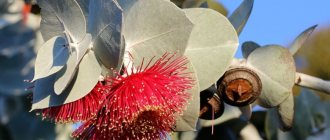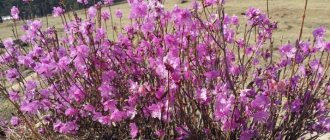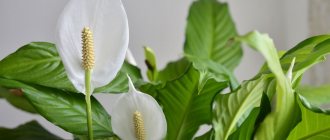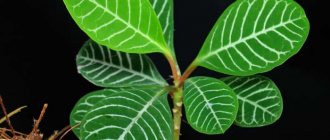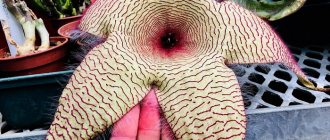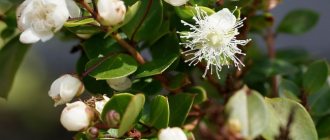Types and varieties of plants
Euphorbia (a flower quite common in our area) belongs to the Euphorbiaceae family. Its “real” name is Euphorbia (after a Moorish physician who often used milkweed in practice). Euphorbia received its Russian name because of the white sap that accumulates in its trunk and leaves.
There are more than 2 thousand species of milkweed! Among them there are wild plants and those that have been domesticated. Euphorbia has species that are perennial and annual plants.
The most popular varieties of indoor milkweed:
- Belozhilkovy. Most often found in apartments. It looks like a small palm tree (up to 1.4-1.6 m in height) with a thick pentagonal trunk (the edges are covered with a nice brownish fringe).
- Mile. Its stems branch strongly right from the root, and are even covered with thorns. Its blooming appearance is very attractive - rich scarlet, white or yellow.
- Poinsettia. It has a very unusual appearance - bright red leaves, which are actually bracts. Interestingly, it blooms in December.
- Head of a jellyfish. The thick, fleshy stems of this milkweed have a lumpy texture and intertwine with each other like a ball of snakes—hence the name.
- Enopla. Very similar in appearance to a cactus. Not very high (maximum 1 m).
- Triangular (triangular). The barrel is very thick and has (as the name suggests) three sides. It can grow up to 2 m. The stems are pressed tightly against each other. The leaves are quite small. Doesn't bloom.
Possible problems
Despite the fact that Euphorbia Belozhilkovy is a fairly resilient succulent, owners may encounter difficulties:
- alternate, gradual falling of the lower leaves is a natural process;
- if leaf fall begins suddenly and is widespread, one of the possible options is an over-moistened or too dry substrate, a cold draft, or nutritional deficiency;
- Of the pests, the mealybug most often affects the crop, but scale insects or spider mites may appear;
- the leaves have drooped - most likely due to overwatering rather than drying out of the substrate;
- the stem rots - excessive watering, especially coupled with low temperature;
- the main shoot has shriveled - the soil has dried out;
- young leaves fall off, and the stem stretches out - it’s too dark.
Euphorbia White-leafed is an easy-to-care succulent, a houseplant for lazy or busy owners. An adult specimen resembles a palm tree with a thick trunk. Requires careful handling; when working, you need to wear gloves because of the sharp spines and poisonous milky sap.
Appearance
It is quite difficult to answer the question of what milkweed looks like. And all because there are 2000 species. So, one type of milkweed may look like a cactus, another looks like a miniature palm tree, and a third looks like a bush or ordinary grass. There are only a few characteristics that unite all this diversity into one family.
- Stem. Very “fleshy”, like all succulents (plants that store water in the stem). Structure, length, color depend on the species. They often have clearly defined edges and scars from fallen leaves.
- The structure of the inflorescence. Each new flower seems to grow from the old one. The flower has no petals and consists of one twisted pistillate floret. Around are the remains of degenerate flowers - stamens, bracts. Blooms for a long time.
- Fetus. Ripens at the end of flowering. It looks like a triangular box with three seeds.
- Leaves. Usually dense, elongated, with reddish veins (but this is not a necessary condition).
- The presence of white milk when a leaf or stem is fractured. This is the only thing that is necessarily present in any type of milkweed!
Growing methods
From seeds
- First, poinsettia seeds are germinated in a small container filled with loose peat and closed with a transparent lid. To ventilate the air, the lid is periodically opened.
- After a couple of weeks, when the first shoots appear, the container is left open and placed in a well-lit place.
- After two true leaves appear, the seedlings are picked and planted in individual pots.
Further care consists of regular watering and fertilizing.
By cuttings
To obtain seedlings, you first need to cut poinsettia cuttings. To do this, in the spring, the leaves are removed from the cut shoots and the cuttings are placed in a greenhouse in a mixture of peat and sand.
Important! Before you start germinating the cuttings, you need to get rid of the milky juice inside the shoots. To do this, simply place the cuttings in water for 15 minutes.
If you maintain 26-28 degrees in the greenhouse, roots will form within a month and the seedlings can be transplanted into pots.
A rooted cutting will not bloom in its first year.
Where and how does it grow
The homeland of milkweed has not been determined. This plant grows in a free range throughout the globe, especially in the continental and subtropical zones. Many indoor species have appeared in Madagascar, South America and Africa. There are species that grow in nature in Europe and Asia, even in our latitudes (but they are rather weeds, and only a few species are cultivated and grown in gardens).
Under what conditions does spurge grow?
- Temperature conditions. The plant is quite accustomed to temperature changes. Under natural conditions, it grows where the temperature difference between night and day is more than 10-15˚C.
- Illumination. In a subtropical climate, daylight hours last for at least 10 hours, which is what those types of milkweed that most often grow in our apartments are accustomed to.
- The soil. Most often sandy or well-drained.
- Water. The plant quickly accumulates moisture during heavy rains and calmly endures periods of the most severe drought.
- Lifespan. It can be either an annual or perennial plant. Indoor specimens live for 10 years.
Euphorbia - description
All species can be divided into annual and perennial. In most cases, the stem is straight and grows tall, but there are varieties that do not have a stem at all. All indoor milkweeds are united by the presence of a milky juice that is released when cut, and it is painted white. This is where the name comes from. It is worth paying attention to the medicinal properties of milkweed:
- It is a natural aphrodisiac and tonic that increases immunity, exhibits antiseptic and antibacterial properties.
- Medicines containing milkweed are used for a quick and effective wound healing process.
- The herb is used to treat cystitis and diarrhea.
- Indoor spurge has a laxative, anthelmintic and diuretic effect.
Why is indoor spurge dangerous?
When buying such a plant for your home, do not forget that it is dangerous. White juice contains saponins, alkaloids, glycosides, toxic compounds and poisonous resins. It is found in all parts of indoor milkweed, and circulates under pressure, so when it breaks, a large portion is released. It is important to transplant carefully, using gloves and keeping it in the house out of the reach of children.
Burns that may remain after contact with milky juice take a long time to heal. If liquid gets inside the body, digestive upset cannot be avoided. When juice gets on your eyes, an inflammatory process occurs, so it is necessary to rinse them as quickly as possible in plenty of running water. There are known cases where a person suffered temporary blindness due to a milkweed flower. Medicines containing the plant are prohibited during pregnancy and lactation. They should not be applied to open wounds.
Benefits and Applications
- Indoor spurge is a rather beautiful plant, so it is often used for decorative purposes.
- Euphorbia is a rubber-bearing plant with tanning properties (though this quality is not much used in industry, but the natives used this property for their needs).
- Euphorbia juice, although poisonous, is used in small doses to treat certain types of diseases.
At home
- Euphorbia is unpretentious and hardy. Perfect for those housewives who forget to water their flowers.
- Euphorbia is used for landscaping classrooms, offices and other institutions. Due to the fact that all types of milkweed can grow quite quickly and up to 1-2 m, they fit perfectly into the office space.
- Euphorbia can also be grown in gardens.
In medicine
- The juice is used as a base for medicines.
- Euphorbia juice has analgesic, anti-inflammatory and antipyretic properties.
Possible diseases
If the conditions of maintenance are violated, the poinsettia gets sick. It could be:
- Gray rot. For treatment, it is necessary to remove the infected parts and treat the plant with an antifungal drug.
- Mosaic virus. Insects bring it to the plant. To cure, you first need to get rid of the carriers of the disease.
- A lack of mineral salts in the soil causes root rot. Frequent watering, fertilizing and using fungicides will help control the disease.
- To get rid of sooty fungus, use a soapy shower and a limestone solution.
How to grow, care and pests/diseases
- Euphorbia and almost all its species are one of the most unpretentious indoor plants that do not require care. But still, a minimum set of conditions for its growth must be met: provide a lot of light (by the way, some types of milkweed are not afraid of direct sunlight!), good soil drainage and the absence of strong drafts.
- Caring for milkweed is easy. Watering should be done moderately. During the rest period, reduce to 1 time every 2-4 weeks. During the growth period, wait until the soil dries to at least 1/3 of its depth. Air humidity should not worry you at all.
- Euphorbia is poisonous, so use gloves when handling it.
- To feed, use cactus fertilizer.
- Homemade spurge is replanted every two years in the spring before the growth period.
- Reproduction most often occurs either by cuttings or seeds. The easiest way to propagate is by seeds - they germinate themselves in the parent pot. But many types of milkweed do not reproduce this way - then you need to cut off the top cuttings, let them dry a little and plant them in sandy soil.
The best quality of milkweed is that it is very resistant to various diseases and is not susceptible to “attacks” from harmful insects. Most often, milkweed gets sick from improper care. So, if you water the spurge too often or plant it in heavy, undrained soil, the flower may disappear.
Varieties of milkweed
This plant stands out among others in the number of known species, and many of them are not at all similar to each other, for example, some specimens look like a palm tree, while others look like a cactus. There are approximately 200 species of milkweed on earth. In our latitudes there are annual and perennial shrubs that have poisonous milky sap found in the stems and roots. There are many ornamental varieties that can be grown outdoors and at home. There is spiny spurge with red flowers, without thorns, without flowers, in general, there are a lot of options.
Euphorbia Mile
This species is also called “brilliant” and is one of the decorative varieties that bloom. Among the people, the milkweed Milya flower is called the “crown of thorns.” This is a small shrub with thorns, which has a large gray stem and bright green oblong leaves. Small flowers are painted yellow. This species is distinguished by its high life expectancy, and it also grows well. For an indoor flower in summer you need good lighting and plenty of watering, and in winter the temperature should not exceed 13°C.
Euphorbia Pallas
This is a perennial plant, which is also popularly called “man root”, and all because of its healing properties. Experiments have shown that it contains lactones with antibacterial and antitumor activity. This species has a root similar to a human figurine. The spurge plant reaches a height of approximately 0.4 m. Its stem is bare or has a slight edge. If you break it, juice will begin to release, which quickly hardens in the air. The indoor plant blooms in May, and then fruits form.
White-veined spurge
This species is considered the most common for home cultivation. It has a ribbed trunk and an attractive cluster of green foliage at the top. Many, growing white-veined spurge at home, consider it a cactus because of its external similarity, but this is not so. With proper care, the plant blooms and even self-sows abundantly. If the seeds fall into a favorable environment, they germinate after 2-3 weeks.
Euphorbia fringed
This is an unpretentious annual plant that is called “mountain snow” in its native North America. The name comes from the fact that when it blooms, it resembles snow on mountain slopes. As an indoor flower, fringed euphorbia is practically not used. If consecration and watering are sufficient, then a lush round course is formed, which can reach 60-100 cm in diameter and height. Euphorbia with white flowers will be an excellent single decoration, and it can also form a composition with other flowers.
Euphorbia triangularis
This plant is large and grows as a bush, reaching a height of 2-3 m. The fleshy stems have pronounced ribs on which small spines are located. The leaves are oblong in shape at the top. Externally, the flower looks like a candelabra with candles. Triangular spurge is easy to care for; for example, it can be placed both in the shade and in direct sunlight. It grows quickly, but at home it does not bloom. Indoor spurge is propagated by cuttings.
Euphorbia cypress
This is a highly branching shrub that does not grow higher than 15-30 cm at home. The branches are erect and they are completely covered with narrow needle-like leaves. At the top are cyanthia (euphorbia flowers) on long stalks. This type of indoor milkweed flower can also be grown outdoors, but in winter it must be covered. It has many fragrant flowers of yellow-green color, but there is also a purple-lilac hue. Flowering occurs in spring and lasts a month.
Euphorbia tirucalli
The presented species consists of a large number of fleshy stems, the thickness of which is similar to a pencil. It has no leaves or spines, but under the right conditions, spurge is covered with beautiful small yellow flowers. It is important to remember that the milky sap of this plant is very poisonous and burns occur if it comes into contact with the skin. This indoor species of milkweed loves light, but it also tolerates partial shade.
Euphorbia comb
This is an evergreen shrub that has a ribbed trunk reaching a height of up to 120 cm. It can be erect and rarely twisted. On the surface of the trunk there are thorns 3 cm long. Comparing indoor varieties of milkweed and the comb variety, it is worth noting that it has yellow-green flowers that are located on a reddish peduncle. The leathery leaves have an oval and elongated shape with a glossy surface. They only grow at the top. This indoor spurge with yellow flowers is easy to grow at home.
Euphorbia flower - care
There is no need to create any special conditions for growing; the main thing is to take into account the basic rules:
- The soil. For indoor milkweed, loose and permeable soil is best. You can choose soil for cactus plants. Another option is to prepare the mixture yourself: mix leaf soil, humus and sand in a ratio of 2:3:2. It is necessary to put drainage at the bottom.
- Feeding and fertilizers. For care, spurge should be fed during the growing season: in spring and summer once a month after watering. If the variety is flowering, then use potassium fertilizers.
- Temperature. The suitable temperature for many types of this indoor plant is +18-25°C. In the warm season, it is recommended to take the pot out into the open air. There are varieties that survive well at low temperatures.
- Lighting. Most existing varieties are sun lovers, so they are not afraid of direct sunlight. There are plants that like diffused light. When spurge is in the shade for a long time, the leaves lose their brightness.
- Watering. In the summer, indoor spurge should be watered once a week, and in winter the amount should be reduced to once a month. If the temperature drops below +12°C, then watering should be stopped altogether. When the soil is very dry, it should be moistened gradually and in small portions. If it is very hot, then spray.
- Trimming. For rejuvenation, the plant must be pruned in mid-summer after flowering. Dried stems should be removed and elongated shoots should be shortened. If the species is flowering, then the young shoots should be left and they will bloom the next year. If you want to get a dense bush at the end of winter, you need to remove all the shoots.
- Diseases. Indoor spurge is susceptible to various fungal diseases. The reason for their occurrence is too frequent watering or stagnation of liquid due to lack of drainage. The presence of fungus is indicated by fallen leaves and the appearance of dark spots on the stems. To cope with the problem, spray with fungicidal agents. Rarely does a flower harbor spider mites, scale insects, and mealybugs. They need to be controlled with insecticides.
- Problems. If the flower does not have enough nutrition, then it will begin to lose leaves. To correct the problem, use phosphorus-containing fertilizers and replant in the spring. When only the leaves from below fall off or the stem wrinkles, this means that the soil has been dry for a long time. If indoor milkweed does not have enough light, then the stem becomes very elongated and the young leaves darken.
Types of propagation of indoor spurge flower
Pilea monetifolia and small-leaved, other species - care at home
To propagate indoor spurge, you can use several methods:
- seed;
- cutting method;
- dividing bushes.
Note! The vegetative method of propagation belongs to the category of the most accessible methods, characterized by ease of planting and care. Seed material makes it possible to grow spherical forms that cannot be propagated by cuttings.
Some varieties can only be grown by dividing the bush. For this purpose, the dug out bush of the plant is divided into a pair of bushes and transplanted into separate containers. It is important to be especially careful when dividing the root system. The method can only be used at a time when the plant is at rest. It is worth considering that there should be no rotting areas left on the planting material. Any suspicion of rot is removed to healthy tissue.
Growing milkweed from seeds
Seed material can be collected independently or purchased at a specialized store. For sowing you will need to prepare a sand-peat mixture. The soil is calcined in the oven for the purpose of disinfection. The seeds must be soaked in water for 24 hours. After the specified period of time, bury the seed in the soil. Cover the crops with plastic material and transfer to a warm room.
Reproduction
Cuttings
Cuttings are best done in October. To propagate a plant by shoots, you will need:
- cut off shoots, the length of which reaches 10 cm, from under the leaf nodes;
- remove lower foliage;
- rinse off the released juice under running water;
- wipe the cut and treat it with crushed charcoal;
- dry the cuttings and plant them in moist sand.
Until the cuttings take root, they must be kept under a film cover. The soil must be systematically moistened. It is very important to move containers with cuttings to a shaded area.
Note! Containers with cuttings must be ventilated every day.
Superstitions and signs about Euphorbia white-veined
In the community of flower lovers, there are many different beliefs about this plant. Let's list a few of the most common and interesting signs:
- It is believed that White-veined Euphorbia has a beneficial effect on the indoor environment, absorbing all the negative energy.
- It is often placed near the computer, in the belief that it protects against radiation and negative energy.
- There are rumors that it is better to place this flower in the corridor, thereby protecting residents from dangers and adversities coming from the outside world.
- If you place a pot with a plant in your workplace, it will attract success and add positive emotions.
- Blooming Euphorbia brings harmony and tranquility to the family.
How to seat
Some types of milkweed, such as Milkweed, can be propagated by dividing the bush.
This should be done at the beginning of the spring or autumn period . The plant is taken out of the pot, the damaged parts of the rhizome are carefully removed and the stems and roots are divided into parts.
If, when dividing the roots, cutting them is required and you need to resort to using a sharp instrument, then you need to sterilize this instrument before use. Fresh root sections must be washed with warm water until the juice stops flowing out and sprinkled with charcoal.
Bush suitable for dividing
The separated parts of the bush should be planted in pots with a prepared drainage layer and special soil. This method of propagation is not an easy test for milkweed, so at first its development will not be intensive.
Flowering in the first year is unlikely . The plant will recover and begin to fully develop in about 2 years.
Watering
It is necessary to water abundantly in spring and summer, moderately in autumn and winter. The frequency of watering depends on the type of milkweed. The more cactus-like it is, the less it needs to be watered.
Deciduous varieties love moisture more, but overwatering should not be allowed, this is especially dangerous for those euphorbias that have a thick, fleshy stem, because it can rot.
It should be watered when the top quarter of the layer is dry. You shouldn't overdry the soil either. Deciduous species in this case may begin to shed their leaves.
Temperature
Euphorbia is very thermophilic, tolerant of temperature changes, but does not tolerate drafts. The optimal temperature in summer for growing plants ranges from 20 to 25 degrees.
In winter, it is recommended to lower it to 14 degrees, especially for flowering varieties, because the cool conditions favor the formation of inflorescences. But at the same time, the temperature should not be allowed to drop below 10 degrees above zero.


